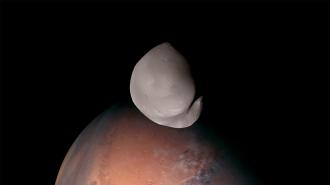The United Arab Emirates Space Agency (UAESA) has just produced the best images ever taken of Mars’ moon Deimos — and they suggest the tiny satellite isn’t what we thought it was.
Mars’ moons: Mars has two moons. The larger of them, Phobos, is 14 miles wide and orbits the planet from a distance of just 3,700 miles, while the smaller one, Deimos, is only 9 miles in diameter and circles it from 14,580 miles away.
“We expect to … advance our fundamental understanding of these two satellites of Mars.”
Justin Deighan
Because Phobos is so much bigger and closer to Mars than Deimos, it’s easier to study during missions to the Red Planet — NASA’s Mars Global Surveyor and the Mars Reconnaissance Orbiter have both taken high-resolution images of the moon during close flybys.
As for Deimos, NASA’s Viking 2 orbiter did swing within 19 miles of the moon, but that was back in 1977, so the technology used for those observations wasn’t as advanced as what we have today.
What’s new? The UAE’s Hope orbiter reached Mars in 2021, and after completing its primary mission to study Mars’ atmosphere up close, the probe was boosted to a higher orbit this year so that it could study the planet in its entirety.
That new orbit not only allowed Hope to observe Deimos from as close as 68 miles — resulting in the highest resolution images of Mars’ moon to date — it also enabled the probe to take the first-ever images of the half of Deimos that permanently faces away from Mars’ surface.
Origin story: Astronomers are interested in both Deimos and Phobos because the more we know about them and how they ended up orbiting Mars, the better our understanding of how the solar system formed.
The long-held belief was that both of Mars’ moons were asteroids captured by its gravitational pull, but based on observations from Hope’s three onboard instruments, it seems Deimos and Phobos have compositions more like Mars itself than captured asteroids.
This suggests that the moons might have formed from bits of material left over after the Red Planet formed, or they may be chunks of Mars that broke free at some point in the past, perhaps following an asteroid impact.
Looking ahead: The mystery surrounding Mars’ moons might soon be cleared up: Japan plans to send a probe to study them and retrieve samples from Phobos in the mid-2020s. The UAESA, meanwhile, has extended Hope’s mission into 2024, giving the probe the opportunity to conduct more flybys of Deimos.
“We have a unique opportunity with Hope, to characterize the composition, thermophysics, and detailed geomorphology of Deimos with these new observations,” said Justin Deighan, Deputy Science Lead of the Emirates Mars Mission.
“We expect to build a better understanding of both Phobos and Deimos’ origins and evolution and advance our fundamental understanding of these two satellites of Mars,” he continued.
We’d love to hear from you! If you have a comment about this article or if you have a tip for a future Freethink story, please email us at tips@freethink.com.
